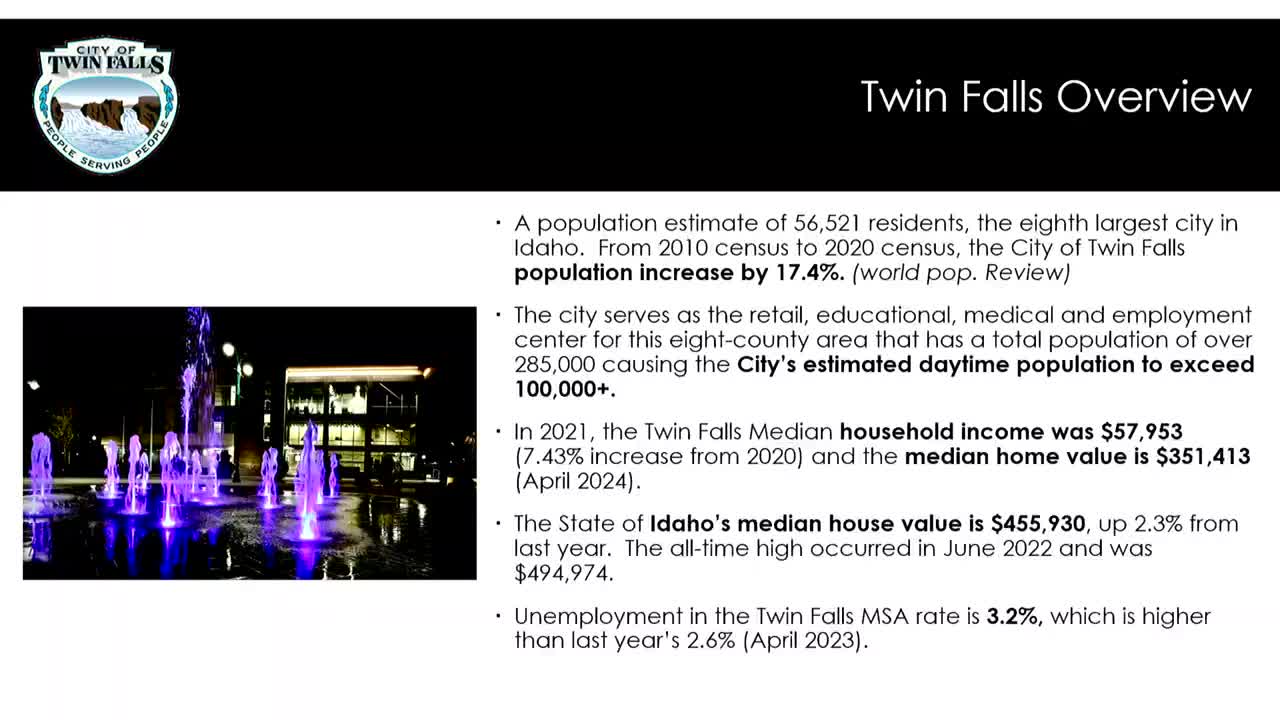City of Twin Falls plans for explosive growth and budget changes
June 03, 2024 | Twin Falls, Twin Falls County, Idaho

This article was created by AI summarizing key points discussed. AI makes mistakes, so for full details and context, please refer to the video of the full meeting. Please report any errors so we can fix them. Report an error »

During a recent government meeting, officials from the City of Twin Falls discussed the implications of the city's growth and its impact on the upcoming budget. The city is experiencing a significant population increase, projected to exceed 65,000 residents by the next census, nearly doubling its population since 2000. This growth is not isolated to Twin Falls; surrounding areas such as Jerome, Buhl, and Kimberly are also expanding, leading to a daily population that surpasses 100,000.
City officials emphasized the importance of viewing the budget through a comprehensive lens that accounts for this broader population. They noted that while total government spending has decreased by $3.2 million, the need for services has increased due to the rising number of residents and commuters. The discussion highlighted the complexities of property tax rates, which may rise even as median home values are projected to decline, underscoring that tax rates are multipliers applied to property values rather than direct indicators of individual tax burdens.
The meeting also addressed the city's strategic plan, originally established in 2012, which will undergo evaluation this fall to ensure its relevance as the city approaches its 2030 and 2040 goals. Officials indicated that new focus areas may be introduced in the next budget cycle, reflecting the evolving needs of the community.
Economic indicators presented during the meeting revealed that Idaho's growth rate, while slower than in previous years, still exceeds the national average. The taxable value of homes in Twin Falls is expected to grow slightly, although not as robustly as in the past. Unemployment remains low, with a strong labor market, and many new residents are retirees, contributing to the demographic shifts in the area.
Overall, the meeting underscored the challenges and opportunities presented by Twin Falls' growth, as officials prepare to navigate the complexities of budgeting for a rapidly changing community.
City officials emphasized the importance of viewing the budget through a comprehensive lens that accounts for this broader population. They noted that while total government spending has decreased by $3.2 million, the need for services has increased due to the rising number of residents and commuters. The discussion highlighted the complexities of property tax rates, which may rise even as median home values are projected to decline, underscoring that tax rates are multipliers applied to property values rather than direct indicators of individual tax burdens.
The meeting also addressed the city's strategic plan, originally established in 2012, which will undergo evaluation this fall to ensure its relevance as the city approaches its 2030 and 2040 goals. Officials indicated that new focus areas may be introduced in the next budget cycle, reflecting the evolving needs of the community.
Economic indicators presented during the meeting revealed that Idaho's growth rate, while slower than in previous years, still exceeds the national average. The taxable value of homes in Twin Falls is expected to grow slightly, although not as robustly as in the past. Unemployment remains low, with a strong labor market, and many new residents are retirees, contributing to the demographic shifts in the area.
Overall, the meeting underscored the challenges and opportunities presented by Twin Falls' growth, as officials prepare to navigate the complexities of budgeting for a rapidly changing community.
View full meeting
This article is based on a recent meeting—watch the full video and explore the complete transcript for deeper insights into the discussion.
View full meeting